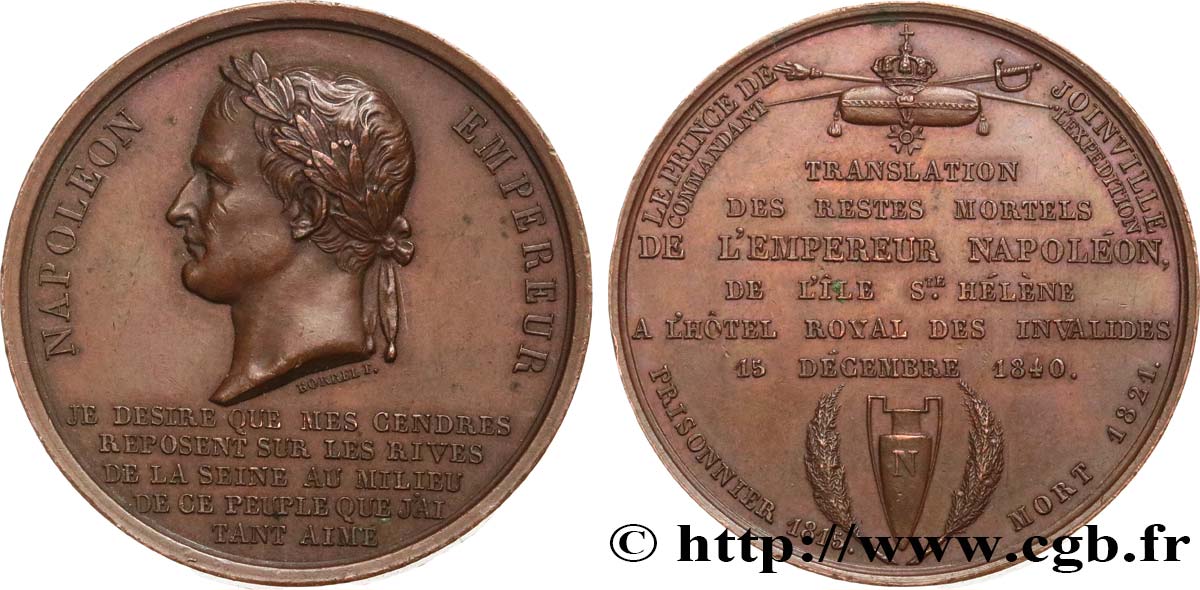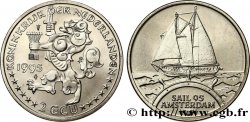fme_562025 - LUIGI FILIPPO I Médaille, Retour des cendres de Napoléon Ier
non disponibile.
Articolo venduto sul nostro negozio (2020)
Prezzo : 95.00 €
Articolo venduto sul nostro negozio (2020)
Prezzo : 95.00 €
Tipo : Médaille, Retour des cendres de Napoléon Ier
Data: 1840
Nome della officina / città: 75 - Paris
Metallo : rame
Diametro : 36,5 mm
Asse di coniazione : 12 h.
Incisore BORREL Maurice Valentin (1804-1882)
Peso : 24,94 g.
Orlo : lisse
Marchio : sans poinçon
Commenti sullo stato di conservazione:
Patine marron hétérogène. Traces de manipulation dans les champs
Diritto
Titolatura diritto : NAPOLÉON - EMPEREUR // JE DÉSIRE QUE MES CENDRES / REPOSENT SUR LES RIVES / DE LA SEINE AU MILIEU / DE CE PEUPLE QUE J'AI / TANT AIMÉ.
Descrittivo diritto : Tête laurée de Napoléon Ier à gauche ; légende autour et en 5 lignes à l’exergue. Signé : BORREL F..
Rovescio
Titolatura rovescio : LE PRINCE DE - JOINVILLE / COMMANDANT - L’EXPÉDITION // TRANSLATION / DES RESTES MORTELS / DE L’EMPEREUR NAPOLÉON, / DE L’ÎLE STE HÉLÈNE / À L’HÔTEL ROYAL DES INVALIDES / 15 DÉCEMBRE 1840. // PRISONNIER 1815 - MORT 1821.
Descrittivo rovescio : Légendes en neuf lignes entre un coussin avec une couronne, la main de justice, un sabre et l’ordre de... et une urne funéraire inscrite N entre deux palmes.
Commento
Intéressante médaille à mettre en relation avec la fme_412242 pour le passage à Rouen des restes mortels de Napoléon Ier en 1840, avec le poinçon Proue (donc réalisée entre 1842 et 1845).
La formule consacrée retour des cendres – le terme « cendres » étant pris non au sens propre mais au sens figuré de « restes mortels d'une personne » – désigne le rapatriement en France, en 1840, à l'initiative d'Adolphe Thiers et du roi Louis-Philippe, de la dépouille mortelle de Napoléon et son inhumation aux Invalides.
En mourant, Napoléon Ier avait manifesté le désir d’être inhumé « sur les bords de la Seine, au milieu de ce peuple français [qu’il avait] tant aimé » dans un codicille de son testament écrit le 16 avril 1821 à Longwood House.
Interesting medal to be linked to fme_412242 for the passage to Rouen of the mortal remains of Napoleon I in 1840, with the hallmark Proue (therefore made between 1842 and 1845). The consecrated formula return of the ashes – the term “ashes” being taken not in the literal sense but in the figurative sense of “mortal remains of a person” – designates the repatriation to France, in 1840, at the initiative of Adolphe Thiers and King Louis-Philippe, of the mortal remains of Napoleon and his burial at the Invalides. Upon dying, Napoleon I had expressed the desire to be buried “on the banks of the Seine, in the midst of this French people [that he had] loved so much” in a codicil of his will written on April 16, 1821 at Longwood House
La formule consacrée retour des cendres – le terme « cendres » étant pris non au sens propre mais au sens figuré de « restes mortels d'une personne » – désigne le rapatriement en France, en 1840, à l'initiative d'Adolphe Thiers et du roi Louis-Philippe, de la dépouille mortelle de Napoléon et son inhumation aux Invalides.
En mourant, Napoléon Ier avait manifesté le désir d’être inhumé « sur les bords de la Seine, au milieu de ce peuple français [qu’il avait] tant aimé » dans un codicille de son testament écrit le 16 avril 1821 à Longwood House.
Interesting medal to be linked to fme_412242 for the passage to Rouen of the mortal remains of Napoleon I in 1840, with the hallmark Proue (therefore made between 1842 and 1845). The consecrated formula return of the ashes – the term “ashes” being taken not in the literal sense but in the figurative sense of “mortal remains of a person” – designates the repatriation to France, in 1840, at the initiative of Adolphe Thiers and King Louis-Philippe, of the mortal remains of Napoleon and his burial at the Invalides. Upon dying, Napoleon I had expressed the desire to be buried “on the banks of the Seine, in the midst of this French people [that he had] loved so much” in a codicil of his will written on April 16, 1821 at Longwood House








 Segnalare un errore
Segnalare un errore Stampate la pagina
Stampate la pagina Condividi mia selezione
Condividi mia selezione Fai una domanda
Fai una domanda Consegnare / vendere
Consegnare / vendere
 Descrittivo
Descrittivo










